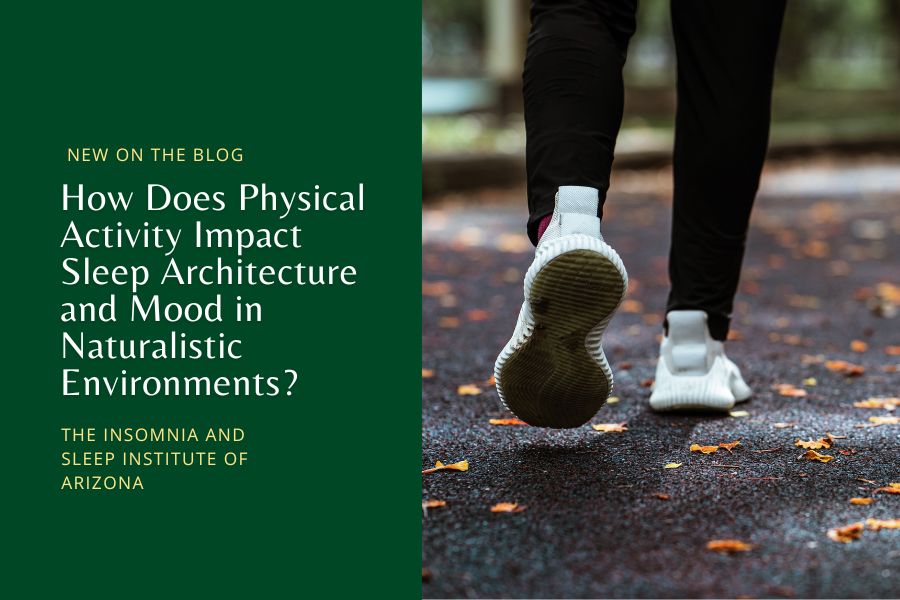Doing regular physical activity is beneficial for the mental and physical well-being of individuals of all ages. Yet, over 80% of adolescents and 27% of adults fall short of the WHO’s recommended activity levels. This shortfall could clash with troubling sleep patterns, with 14.5% of US adults in 2020 struggling to fall asleep most days.
Fortunately, there are studies about the relationship between physical activity, sleep architecture, and mood in naturalistic environments. This research can help us better understand how movement impacts our nightly rest and daily emotional state.
What is Sleep Architecture and Why is it Important?
Sleep architecture is a structured organization of various sleep stages. These stages are experienced by an individual during their night’s rest. The cycles contain different sleep stages that are important in maintaining overall health and well-being. Specifically, sleep architecture is generally divided into two main types. The Non-Rapid Eye Movement (NREM) sleep and Rapid Eye Movement (REM) sleep.
NREM sleep is subdivided into three stages. Each has distinct characteristics and functions:
- N1 (Stage 1): The lightest stage of sleep. Transition from wakefulness to sleep. Easily disrupted. Comprises 5-10% of total sleep.
- N2 (Stage 2): The most substantial portion of sleep. Characterized by sleep spindles and K-complexes on an EEG. Occupies about 50% of total sleep time.
- N3 (Stage 3): Deep sleep, also known as slow-wave sleep (SWS). Crucial for physical recovery and growth. Involves delta waves. Represents 15-20% of sleep.
Rapid Eye Movement (REM) sleep, from distinct NREM stages, is marked by rapid eye movements, vivid dreaming, and significant brain activity similar to wakefulness. It usually accounts for 20-25% of total sleep time.
A typical night’s sleep involves multiple cycles of NREM and REM stages, usually around 90-110 minutes each. Early in the night, NREM stages, especially N3, dominate. And as the night progresses, REM sleep periods lengthen.
Importance of Sleep Architecture
Restorative Functions: NREM and REM sleep stages contribute uniquely to physical and mental restoration. In N3 or stage 3 of NREM,sleep aids in tissue repair, immune function, and energy restoration. This is beneficial for cognitive functions such as learning, memory consolidation, and emotional regulation.
Cognitive Performance: Proper sleep architecture supports cognitive processes. Poor sleep can make learning difficult. During REM sleep, the brain processes and consolidates memories, enhancing the learning and problem-solving skills of an individual.
Emotional Health: Sleep architecture impacts emotional stability. REM sleep helps process emotions and reduces stress, improving mental health and resilience.
Physical Health: When someone’s sleep architecture is disrupted, it may lead to various health issues. Lack of sufficient deep sleep (N3) may result in fatigue, weakened immunity, and slower physical recovery. Additionally, insufficient REM sleep is linked to cognitive impairments (such as Alzheimer’s disease) and mood disorders.
Well-being: Balanced sleep architecture ensures that the body undergoes necessary cycles for rejuvenation. Disruptions, such as those caused by sleep disorders (e.g., sleep apnea, and insomnia), can lead to different chronic health problems, such as cardiovascular diseases, diabetes, or obesity.
How Does Physical Activity Influence Sleep Quality?
Doing physical activities (such a walking, running, swimming, or even gardening) is our health. It can also impact our sleep quality. In addition, studies have consistently shown that regular exercise can significantly improve sleep in many ways.
Improved Sleep Quality and Reduced Sleep Disorders
A systematic review such as the “The Effect of Physical Activity on Sleep Quality and Sleep Disorder: A Systematic Review” examined the effect of physical activity on sleep and highlighted several their major findings. They have found that regular physical activity, particularly moderate-intensity exercise, is linked to better overall sleep quality. This includes falling asleep faster (reduced sleep latency) and experiencing deeper, more restorative sleep.
Furthermore, the study also suggests that physical activity is needed to managing sleep disorders like insomnia (Difficulty falling asleep, staying asleep, or both). Still, it’s important to note that timing is important. High-intensity workouts close to bedtime might hinder sleep. While moderate-intensity exercise earlier in the day appears to be more beneficial.
The study also acknowledges that factors such as gender, age, and the type, duration, and consistency of exercise can influence how much physical activity improves sleep. Further research to determine optimal exercise regimens for sleep health might be needed.
The Link Between Physical Activity and Sleep in University Students
A study conducted among university students in Saudi Arabia provides real-world evidence of the connection between physical activity and sleep quality. In their study, the researcher found that a majority of the students reported poor sleep and were physically inactive. This could highlight a potential link between a sedentary lifestyle and sleep disturbances.
Meanwhile, the study also stated that there’s a significant association between physical activity and good sleep quality. Those students who were physically active were more likely to report better sleep compared to their inactive counterparts. This suggests that incorporating physical activity into their routines could significantly improve their sleep.
The Dose Makes the Difference: Exploring Activity Levels and Sleep
Lastly, another study investigated the association between the level and type of physical activity with sleep quality in adults (aged 25–64). The findings suggest a dose-response relationship, meaning that there’s an optimal amount of exercise for better sleep.
They have identified extremely high levels of daily physical activity, including occupational activity, as a potential risk factor for sleep problems. This was particularly true for difficulty falling asleep. These findings emphasize the importance of finding a balanced exercise routine. Regardless, while some activity is undoubtedly beneficial, pushing yourself too hard might have the opposite effect on your sleep.
How Does Physical Activity Impact Sleep Architecture and Mood in Naturalistic Environments?
In the study titled “The effects of physical activity on sleep architecture and mood in naturalistic environments”, the authors examined how physical activity influences sleep structure and psychological wellbeing outside the controlled settings of a laboratory. They asked the participants to use modern wearable technology to examine how different intensities of physical activity impacted sleep stages and mood over extended periods in real-world environments.
Methodology
In this study, 82 participants were monitored over several months. They used photoplethysmography coupled with accelerometers and smartphone assessments. Then after filtering the data, the final analysis included 2287 days of observations from 65 participants. These participants wore devices nearly all day. They report detailed daily measurements of physical activity, sleep parameters, and self-reported mood.
On top of that, the average participant spent 31.2 minutes per day in low-intensity physical activity (LPA) and 16.5 minutes in moderate-to-vigorous physical activity (MVPA), with a significant portion of the day (702.5 minutes) being sedentary.
Findings on Physical Activity and Sleep
The study found a significant inverse relationship between physical activity levels and sedentary behavior on sleep architecture. Specifically, low-intensity and moderate-to-vigorous physical activity (MVPA) were linked to increased non-rapid eye movement (NREM) sleep and decreased rapid eye movement (REM) sleep, along with longer REM sleep latency. Whereas, higher levels of sedentary behavior correlated with less NREM sleep, more REM sleep, and shorter REM latency.
Mood and Sleep Quality
These alterations in sleep architecture had notable psychological effects. Increased REM latency and a lower REM/NREM ratio, particularly in the first 180 minutes of sleep, were associated with improved wellbeing. The researchers reported that participants felt more energized, experiencing less stress, and perceiving their sleep as more restful. So the study thus suggests that physical activity not only influences sleep stages. But also contributes to overall mood enhancement.
Detailed Sleep and Activity Metrics
On average, participants spent 702.5 minutes per day in sedentary activities, 31.2 minutes in low-intensity physical activity, and 16.5 minutes in MVPA. Even more,they spent about 7.6 hours in bed, with 6.6 hours of total sleep time (TST). The average sleep efficiency (SE) was high, with 96% of nights showing SE greater than 80%. REM sleep constituted 21% of the TST.
Implications for Stress and Psychological Wellbeing
Their findings were the association between low-intensity physical activity and reduced morning stress levels. This stress reduction was linked to better sleep metrics, such as increased TST, higher NREM sleep percentage in the first 3 hours, longer REM latency, and improved subjective sleep quality (SSQ). Meaning, that this study says that both physical activity and quality sleep contribute independently to stress reduction.
Comparisons with Laboratory Studies
What’s more, the study’s findings extend the results of previous laboratory-based research into naturalistic environments, confirming that physical activity reduces REM sleep and increases REM latency. Unlike laboratory studies, which often observe effects over a single day, this study demonstrated consistent relationships over weeks and months, underscoring the lasting impact of physical activity on sleep and mood.
Challenges and Limitations
The study also has several limitations. First, it did not differentiate between types of physical activities, which could have varying impacts on sleep and mood. Additionally, the sample was restricted to young adults. A need for future research across more diverse age groups and demographics are suggested by the researchers. Not to mention,the wearables that are used, while advanced, are not as accurate as polysomnography (PSG), the gold standard for sleep measurement.
Future Research Directions
Further research should investigate the specific types of physical activities that most benefit sleep and mood. It would also be valuable to explore these effects over longer periods, potentially through longitudinal studies. Understanding the neurobiological mechanisms behind these changes in sleep architecture could provide deeper insights into how physical activity influences sleep and overall health.
Disclaimer: The information provided in this summary is based on the study. While efforts have been made to represent the study’s findings accurately, this summary should not be considered a substitute for the original research article or professional medical advice.
Readers are encouraged to consult with healthcare professionals or researchers for personalized guidance on matters related to physical activity, sleep, and mental health. Besides, individual responses to physical activity and sleep may vary. S further research may be needed to understand the implications of these findings fully.
How Can You Incorporate Physical Activity into Your Daily Routine?
Combining physical activity into your daily routine can seem challenging. However it’s helpful for improving your sleep, mood, and overall health. Some practical and easy-to-follow tips we recommed to help you become more active every day are:
Start Small: Don’t overwhelm yourself by trying to do too much at once. Begin with small, manageable changes. For instance, take a short walk during your lunch break or do a few minutes of stretching in the morning. These small steps can make a big difference over time.
Set Realistic Goals: Setting achievable goals is crucial. Aim for at least 30 minutes of moderate-intensity activity most days of the week. If that seems daunting, break it down into shorter sessions. For example, three 10-minute walks throughout the day can be just as beneficial as one longer session.
Make It Fun: Choose activities you enjoy. Whether it’s dancing, biking, swimming, or playing a sport, having fun makes it easier to stick with your routine. Mix things up to keep it interesting and prevent boredom.
Incorporate Activity into Daily Tasks: Look for opportunities to be active throughout your day. Take the stairs instead of the elevator. Or even just parking further from the entrance to add a few extra steps. Even household chores like gardening or cleaning can help you stay active. There are a lot of small ways that we don’t notice but we can do to make us active.
Use Technology: Also we recommend using technology to your advantage. There are a lot of wearable fitness trackers that can monitor your activity levels and remind you to move. Many apps provide workout routines and motivational tips to keep you on track. You just need to check and find the best and accurate one.
Stay Accountable: Find a workout buddy or join a fitness group. Having someone to share your progress with can keep you motivated. You can also keep a journal to track your activities and see your improvements over time.
Create a Routine: Incorporate physical activity into your daily schedule like any other important task. You can set aside specific times for exercise, and treat them as non-negotiable appointments. Over time, it will become a natural part of your day.
Combine with Other Activities: Combine physical activity with other daily routines. Walk or bike to work if possible. Or while watching TV, do some light exercises like squats or stretching. Multitasking can help you stay active without sacrificing other activities.
Take Breaks: If you have a sedentary job, take short breaks to move around. Stand up, stretch, or take a quick walk. These breaks (even just a minute) can help reduce the negative effects of prolonged sitting and energize you.
Reward Yourself: Celebrate your achievements, no matter how small they are. Rewarding yourself for reaching your goals can boost motivation. Treat yourself to something enjoyable that aligns with your healthy lifestyle.
Listen to Your Body: Pay attention to how your body feels. If you’re tired or sore, it’s okay to rest. Pushing too hard can lead to burnout or injury. Balance is key to maintaining a sustainable routine.
Take Control of Your Sleep Today!
Our ISIA team of specialists is 100 % dedicated to setting the standard for sleep medicine practice in Arizona. Dealing with insomnia, sleep apnea, or any other type of sleep disorder, our top-rated experts are here to help.
So, if you are ready, you can contact us anytime today and schedule an appointment. Take the first step towards better sleep and improved mood. Experience the difference with The Insomnia and Sleep Institute of Arizona – we are your partners in achieving restful sleep and a happier, healthier life.
References
Alnawwar, M. A., Alraddadi, M. I., Algethmi, R. A., Salem, G. A., Salem, M. A., & Alharbi, A. A. (2023). The Effect of Physical Activity on Sleep Quality and Sleep Disorder: A Systematic Review. Curēus. https://doi.org/10.7759/cureus.43595
Dubinina, E., Korostovtseva, L. S., Rotar, O., Amelina, V., Boyarinova, M., Mikhail Bochkarev, Shashkova, T., Baranova, E., Libis, R., Dmitry Duplyakov, Yurii Sviryaev, Konradi, A., & Shlyakhto, E. (2021). Physical Activity Is Associated With Sleep Quality: Results of the ESSE-RF Epidemiological Study. Frontiers in Psychology, 12. https://doi.org/10.3389/fpsyg.2021.705212
Mohamed Salih Mahfouz, Suhaila Abdalkarim Ali, Alanoud Yahya Bahari, Reham Eissa Ajeebi, Hadeel Jaber Sabei, Sara Yahya Somaily, Yusra Ahmed Madkhali, Reem Hady Hrooby, & Roa’a Nasser Shook. (2020). Association Between Sleep Quality and Physical Activity in Saudi Arabian University Students. Nature and Science of Sleep, Volume 12, 775–782. https://doi.org/10.2147/nss.s267996
Products – Data Briefs – Number 436 – June 2022. (2024). https://www.cdc.gov/nchs/products/databriefs/db436.htm
The Global Status Report on Physical Activity 2022. (2022). Who.int. https://www.who.int/teams/health-promotion/physical-activity/global-status-report-on-physical-activity-2022





